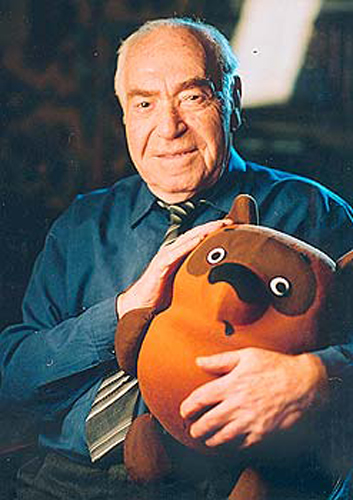Title of the work
Country of the First Edition
Country/countries of popularity
Original Language
First Edition Date
First Edition Details
Икар и мудрецы [Icarus and Sages (Ikar i mudretsy)]. Directed and written by Fyodor Khitruk. Music by Sándor Kallós. Moskva: Soyuzmultfilm, 1976.
Running time
Date of the First DVD or VHS
Available Onllne
The movie is available on the official “Soyuzmultfilm” youtube channel (accessed: August 17, 2018).
Genre
Animated films
Hand-drawn animation (traditional animation)*
Humor
Short films
Target Audience
Children (6+)
Cover

We are still trying to obtain permission for posting the original cover.
Author of the Entry:
Hanna Paulouskaya, University of Warsaw, hannapa@al.uw.edu.pl
Peer-reviewer of the Entry:
Elżbieta Olechowska, University of Warsaw, elzbieta.olechowska@gmail.com
Susan Deacy, University of Roehampton, s.deacy@roehampton.ac.uk

Courtesy of the project www.kino-teatr.ru (accessed: June 28, 2018).
Fyodor Khitruk
, 1917 - 2012
(Animator, Director)
Fyodor Khitruk was an outstanding Russian and Soviet animator, animation director, screen writer, pedagogue, and translator. He made movies for children as well as for adults. His first movie История одного преступления (A Story of One Crime, 1962) is perceived as the beginning of the new wave in Soviet animation. His most famous movies for children are his Winnie-the-Pooh series. He is also famous for Остров (An Island, 1973), Фильм, фильм, фильм (Film, Film, Film, 1968), Человек в рамке (A Man in a Frame, 1966). He taught for many years on courses for directors and has created a school of Russian animation.
Fyodor Khitruk was awarded by many orders and won many competitions.
Bio prepared by Hanna Paulouskaya, University of Warsaw, hannapa@al.uw.edu.pl
Summary
The movie tells the story of Icarus who lives among the sages. “All his neighbours, clever men, have already found their place in life and dedicated their leisure to philosophical conversations. […] And this one was… an eccentric.” During the movie Icarus tries to fly many times and falls watched by the eyes of the clever men, who tell him Latin proverbs. These “unquestionable truths” written on monuments tumble on fallen Icarus from heaven. Nevertheless Icarus tries again using new contraptions.
At some point a miracle happens and Icarus flies (colour is added to the movie, and calm music changes into a solemn one). But the proverb (“Bene qui stat non moveatur”) finds him in the sky and makes him fall. First, the letters of the proverb are written on clouds (on black clouds), they gather in one huge dark mass squeezing Icarus between them. Afterwards the cloud is transformed into a black monument inscribed with the proverb; the monument falls burying Icarus beneath.
Schoolchildren with teachers come to the monument and recite proverbs in Latin. But among the pupils there is one curious boy who looks at the sky and around, and who, after finding Icarus’s feathers, makes his own wings. The boy attempts to fly; in the background we hear Icarus’ flight theme.
Analysis
The movie is based on the contradiction of scholastic dogmatic knowledge and curiosity. It may be interpreted as a metaphor of school and growing up, and in a broader sense as a symbol of life with open eyes and courage. Although Soviet authorities during the whole history of the regime wanted to educate and discipline students, at the same time, pathos of discoveries and fearlessness were always present in the educational discourse. It is hard to say whether it was a cartoon addressed to some real situation or whether the movie aimed to invoke a spirit of freedom and enlightenment. In any case the atmosphere of the movie invites the viewer to become Icarus and not to be afraid of falling.
In a late interview, Fëdor Khitruk said that he regretted adding a happy ending to the movie. He would have preferred to finish with the black monument standing where Icarus fell. He said that he did not have enough courage to promote this ending.*
*Khitruk, Fëdor [Хитрук, Фёдор], Профессия аниматор [The Profession of Animator (Professiia animator)], t. 1, Moskva: Gaiatri, 2008, 180–181.
Further Reading
Khitruk, Fëdor [Хитрук, Фёдор], Профессия аниматор [The Profession: Animator (Professiia animator)], t. 1, Moskva: Gaiatri, 2008, 175–183.
Director's bio at kino-teatr.ru (accessed: August 17, 2018).
Profile at kinopoisk.ru (accessed: August 17, 2018).
Profile at animator.ru (accessed: August 17, 2018).


